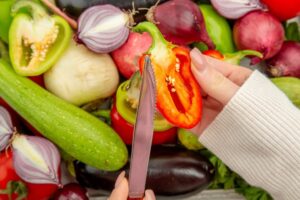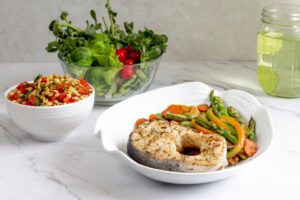The Health & Wellness Blog

How to Start an Anti-Inflammatory Diet
Many health problems in which chronic inflammation is also responsible. It can cause joint pain, fatigue, autoimmune diseases, heart disease, even depression. Fortunately, your fork is one of your strongest weapons in the war on inflammation. Starting an anti-inflammatory diet doesn’t need to be daunting. It’s not about restriction. It’s about choosing foods that fuel your body, cause less stress and support long-term health.
Eating like that can change your life. It is proven to be beneficial for chronic conditions and boosts your energy and resilience. Let’s walk through how to start an anti-inflammatory diet the right way, with clear steps, practical tips, and expert-backed advice.
What Is an Anti-Inflammatory Diet?
An anti-inflammatory diet focuses on whole, unprocessed foods. These foods are rich in antioxidants, healthy fats, fibre, and plant-based compounds. They help calm the body’s inflammatory response. Instead, this plan emphasises nourishment and balance, not fad diets or rigid plans.
Key Features of an Anti-Inflammatory Diet:
- Emphasises vegetables, fruits, legumes, whole grains, nuts, seeds, and fatty fish
- Prioritises healthy fats like olive oil, avocados, and omega-3s
- Limit processed foods, refined sugars, red meats, and artificial additives
- Includes herbs and spices with anti-inflammatory properties (e.g., turmeric, ginger, cinnamon)
Quick Guide: Anti-Inflammatory Diet Essentials
- Eat More: Leafy greens, cruciferous vegetables, berries, fatty fish, legumes, whole grains, nuts, seeds, and anti-inflammatory herbs and spices like turmeric and ginger.
- Cut Back On: Processed foods, refined sugar, trans fats, red and processed meats, and artificial additives.
- Choose Healthy Fats: Extra virgin olive oil, avocado, walnuts, flaxseeds, and wild-caught fish.
- Stay Hydrated: Drink plenty of water and incorporate herbal teas like green tea, ginger, and turmeric.
- Plan Ahead: Keep a well-stocked kitchen, prep ingredients in advance, and use a grocery list focused on whole foods.
- Support Your Gut: Include fermented foods like yogurt, kimchi, sauerkraut, and kefir.
- Be Flexible: Progress matters more than perfection—aim for consistency, not restriction.
- Listen to Your Body: Track how foods affect your energy, mood, digestion, and overall well-being.
Step-by-Step Guide: How to Start an Anti-Inflammatory Diet
1. Clean Out Your Pantry
Start by removing foods that trigger inflammation. This includes:
- Processed snacks and sugary cereals
- Refined flours and baked goods
- Vegetable oils high in omega-6s (like corn, soybean, or canola oil)
- Packaged items with long ingredient lists or artificial additives
Pro Tip: Use extra virgin olive oil, avocado oil, or cold-pressed flaxseed oil. These oils are healthier than inflammatory cooking oils for dressings.

2. Stock Up on Anti-Inflammatory Staples
Build your kitchen around whole, nutrient-dense foods. Some essentials include:
- Leafy greens (spinach, kale, arugula)
- Cruciferous vegetables (broccoli, cauliflower, Brussels sprouts)
- Colourful fruits (berries, oranges, pomegranate)
- Wild-caught salmon or sardines
- Lentils, chickpeas, and black beans
- Brown rice, quinoa, or buckwheat
- Raw nuts and seeds (especially walnuts, chia, and flax)
- Spices like turmeric, black pepper, rosemary, and oregano
Important Tip: Create a weekly grocery list and batch-cook base ingredients for easier meals throughout the week.
3. Prioritise Plant-Based Meals
Plants are naturally rich in phytonutrients, fibre, and antioxidants. Aim for at least half your plate to come from vegetables and fruits at every meal.
Pro Tip: Add a side salad to your lunch and dinner for an easy way to up your veggie intake without much effort.
4. Include Anti-Inflammatory Fats
Healthy fats reduce inflammatory markers in the body. Incorporate sources like:
- Avocados
- Extra virgin olive oil
- Fatty fish (2-3 servings per week)
- Walnuts and flaxseeds
Avoid trans fats and hydrogenated oils at all costs, as these are among the most inflammatory.
5. Balance Blood Sugar
Spikes in blood sugar can lead to inflammation. Choose high-fiber carbohydrates and pair them with healthy fats and proteins to slow absorption.
Example: Swap white rice for quinoa and pair it with roasted vegetables and grilled salmon.
To Maximise Your Anti-Inflammatory Diet
- Drink Herbal Teas: Green tea, ginger tea, and turmeric lattes (unsweetened) are easy inflammation fighters.
- Spice It Up: Use anti-inflammatory spices liberally. Turmeric combined with black pepper increases bioavailability.
- Go Organic When Possible: Choosing organic can cut down pesticide exposure. This helps reduce inflammation, especially with foods like berries and leafy greens.
- Hydrate Well: Water supports detoxification and cellular repair. Aim for at least 8 cups per day.
- Don’t Fear Carbs: Choose whole grains and legumes over refined options. They provide fibre, which supports gut health—a critical factor in inflammation control.
Common Mistakes to Avoid
1. Overhauling Your Diet Overnight
Going from a standard diet to a completely anti-inflammatory one can feel overwhelming. Instead, focus on one change at a time, such as switching your breakfast or packing an anti-inflammatory lunch.
2. Ignoring Hidden Inflammatory Ingredients
Even “healthy” packaged foods can contain inflammatory oils, added sugars, or emulsifiers. Read labels carefully.
3. Not Planning Ahead
Without meal prep or planning, it’s easy to fall back into old habits. Spend a few minutes on the weekend prepping ingredients like roasted veggies, grains, or soups.
4. Being Too Restrictive
This isn’t about perfection. If you slip up, don’t stress. The goal is consistency, not rigidity.
Pro Tip: If you’re eating out, look for grilled proteins, vegetable sides, and request olive oil-based dressings.
Advanced Strategies and Long-Term Insights
Support Gut Health
The gut and inflammation are closely linked. Add fermented foods like sauerkraut, kimchi, kefir, and plain yogurt to your meals to support a healthy gut microbiome.
Consider Intermittent Fasting
Intermittent fasting, such as a 12- to 16-hour overnight fast, can help reduce inflammation. It may also improve metabolic health for certain individuals. Check with a healthcare provider before starting.
Supplement Smartly
If you’re not getting enough omega-3s from your diet, consider a high-quality fish oil supplement. Vitamin D, magnesium, and curcumin supplements can help, but get professional advice first.
Track Your Symptoms
Everyone’s body reacts differently. Consider journaling your meals and noting how your body feels—energy, digestion, mood, joint comfort. This can help you identify trigger foods or top performers.

FAQ’S: Anti-Inflammatory Diet Basics
What is the main goal of an anti-inflammatory diet?
To reduce chronic inflammation through nourishing, whole foods. This helps prevent or manage conditions like arthritis, autoimmune disease, and cardiovascular issues.
Is the anti-inflammatory diet the same as the Mediterranean diet?
They overlap significantly. The Mediterranean diet is one of the best anti-inflammatory models due to its focus on healthy fats, fish, vegetables, and grains.
Can I follow an anti-inflammatory diet if I’m vegetarian or vegan?
Absolutely. Plant-based diets can reduce inflammation. They work best when you eat whole foods, legumes, nuts, seeds, and healthy fats like avocado and olive oil.
How quickly will I notice results?
Some people feel improvements in energy, digestion, and mood within days, while others may take a few weeks. Reducing inflammation is a gradual process.
Do I need to cut out all sugar and carbs?
No. The goal is to minimise added sugars and refined carbohydrates. Whole food sources of carbs like sweet potatoes, oats, and fruit are encouraged.
Can children follow an anti-inflammatory diet?
Yes, with guidance. The anti-inflammatory diet is simply a healthier way of eating and is safe for people of all ages.
Start Simple, Stay Consistent
An anti-inflammatory diet isn’t just about what to cut out. It’s about eating foods that agree with your body. Avoid processed foods such as any packaged processed food.
You don’t have to nail it; you just have to be intentional. Baby steps are infinitely better than big changes you can’t maintain. How to cope with climate anxiety: Listen to your body, remain curious and adapt as you need. This is good for your health.
Eat anti-inflammatory foods. Work with a grocery list to get started. Then, cook some easy meals for the week. The journey begins with one plate—and one choice—at a time.









